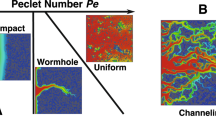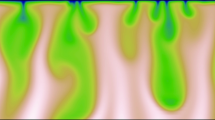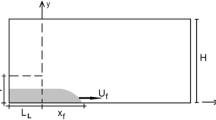Abstract
We investigate theoretically the impact of adding convective dissolution to the sharp interface problem of gravity current propagation along a sloping permeability jump. Three different dissolution modes are explored: constant dissolution, dissolution with simultaneous shutdown and dissolution with sequential shutdown. The last two modes are bookend opposites that make different assumptions about ambient mixing. For simultaneous (sequential) shutdown, different portions of the gravity current interface experience dissolution identically (differently). To gage the effectiveness of dissolution for trapping e.g., supercritical CO\(_2\), we consider the evolution of storage efficiencies and examine the impact of changing the dissolution strength, the time, \(t_1\), for the onset of shutdown and, for \(t_1 < \infty\), the e-folding decay time, \(t_2\), characterizing dissolution decay. We also highlight the phenomenon of intermediate run-out, a state where there is a balance between the fluid supplied to the gravity current vs. that lost by dissolution and basal draining. The state in question is transient because, for time \(t>t_1\), shutdown decreases the rate of dissolution. The ensuing readjustment causes a remobilization of the previously-arrested gravity currents and their subsequent (though not indefinite) elongation. Our analysis concludes by studying unsteady sources, which provides keen insights into similarities and differences between simultaneous vs. sequential shutdown.













Similar content being viewed by others
Notes
Formally speaking, the notion of a thin upper layer is inconsistent with the neglect of an ambient return flow in the context of Fig. 2 where motions in the ambient are ignored. We include the case of a thin upper layer for two reasons, i.e., (i) doing so provides a limiting case that helps to contextualize instances where \(t_1^* \not \rightarrow 0\), and, (ii) the dynamical influence of the ambient is, in any event, expected to be relatively minor when the mobility ratio is small (Pegler et al. 2014). The mobility ratio is defined as the ratio of dynamic viscosities of the injectate to the ambient.
References
Acton, J.M., Huppert, H.E., Worster, M.G.: Two-dimensional viscous gravity currents flowing over a deep porous medium. J. Fluid Mech. 440, 359–380 (2001). https://doi.org/10.1017/S0022112001004700
Bharath, K.S., Flynn, M.R.: Buoyant convection in heterogeneous porous media with an inclined permeability jump: an experimental investigation of filling box-type flows. J. Fluid Mech. (2021). https://doi.org/10.1017/jfm.2021.542
Bharath, K.S., Sahu, C.K., Flynn, M.R.: Isolated buoyant convection in a two-layered porous medium with an inclined permeability jump. J. Fluid Mech. 902, 22 (2020). https://doi.org/10.1017/jfm.2020.599
Bolster, D.: The fluid mechanics of dissolution trapping in geologic storage of \(\text{ CO}_2\). J. Fluid Mech. 740, 1–4 (2014). https://doi.org/10.1017/jfm.2013.531
Bryant, S.L., Lakshminarasimhan, S., Pope, G.A.: Buoyancy-dominated multiphase flow and its effect on geological sequestration of \(\text{ CO}_2\). SPE J. 13(4), 447–454 (2008)
Doster, F., Nordbotten, J., Celia, M.A.: Impact of capillary hysteresis and trapping on vertically integrated models for \(\text{ CO}_2\) storage. Adv. Water Resour. 62, 465–474 (2013)
Goda, T., Sato, K.: Gravity currents of carbon dioxide with residual gas trapping in a two-layered porous medium. J. Fluid Mech. 673, 60–79 (2011). https://doi.org/10.1017/S0022112010006178
Hidalgo, J.J., MacMinn, C.W., Juanes, R.: Dynamics of convective dissolution from a migrating current of carbon dioxide. Adv. Water Resour. 62, 511–519 (2013)
Huppert, H.E., Neufeld, J.A.: The fluid mechanics of carbon dioxide sequestration. Annu. Rev. Fluid Mech. 46, 255–272 (2014). https://doi.org/10.1146/annurev-fluid-011212-140627
Huppert, H.E., Woods, A.W.: Gravity-driven flows in porous layers. J. Fluid Mech. 292, 55–69 (1995). https://doi.org/10.1017/S0022112095001431
Kumar, A., Ozah, R., Noh, M., Pope, G.A., Bryant, S., Lake, L.W.: Reservoir simulation of \(\text{ CO}_2\) storage in deep saline aquifers. SPE J. 10(3), 336–348 (2005)
Liyanage, R., Cen, J., Krevor, S., Crawshaw, J.P., Pini, R.: Multidimensional observations of dissolution-driven convection in simple porous media using x-ray CT scanning. Transp. Porous Media 126(2), 355–378 (2019)
Lyle, S., Huppert, H.E., Hallworth, M., Bicle, M., Chadwick, A.: Axisymmetric gravity currents in a porous medium. J. Fluid Mech. 543, 293–302 (2005). https://doi.org/10.1017/S0022112005006713
MacMinn, C.W., Juanes, R.: Buoyant currents arrested by convective dissolution. Geophys. Res. Lett. 40(10), 2017–2022 (2013). https://doi.org/10.1002/grl.50473
MacMinn, C.W., Szulczewski, M.L., Juanes, R.: \(\text{ CO}_2\) migration in saline aquifers. Part 2. Capillary and solubility trapping. J. Fluid Mech. 688, 321–351 (2011)
Nordbotten, J.M., Celia, M.A.: Similarity solutions for fluid injection into confined aquifers. J. Fluid Mech. 561, 307–327 (2006). https://doi.org/10.1017/S0022112006000802
Pegler, S.S., Huppert, H.E., Neufeld, J.A.: Fluid injection into a confined porous layer. J. Fluid Mech. 745, 592–620 (2014). https://doi.org/10.1017/jfm.2014.76
Pritchard, D.: Gravity currents over fractured substrates in a porous medium. J. Fluid Mech. 584, 415–431 (2007). https://doi.org/10.1017/S0022112007006623
Sahu, C.K., Flynn, M.R.: Filling box flows in porous media. J. Fluid Mech. 782, 455–478 (2015)
Szulczewski, M.L., MacMinn, C.W., Herzog, H.J., Juanes, R.: Lifetime of carbon capture and storage as a climate-change mitigation technology. Proc. Natl. Acad. Sci. USA 109(14), 5185–5189 (2012). https://doi.org/10.1073/pnas.1115347109
Szulczewski, M.L., Hesse, M.A., Juanes, R.: Carbon dioxide dissolution in structural and stratigraphic traps. J. Fluid Mech. 736, 287–315 (2013). https://doi.org/10.1017/jfm.2013.511
Vella, D., Huppert, H.E.: Gravity currents in a porous medium at an inclined plane. J. Fluid Mech. 555, 353–362 (2006). https://doi.org/10.1017/S0022112006009578
Zhao, W., Ioannidis, M.A.: Convective mass transfer across fluid interfaces in straight angular pores. Transp. Porous Media 66(3), 495–509 (2007)
Funding
Funding was provided by NSERC.
Author information
Authors and Affiliations
Corresponding author
Ethics declarations
Conflict of interest
The authors have no relevant interests to disclose.
Additional information
Publisher's Note
Springer Nature remains neutral with regard to jurisdictional claims in published maps and institutional affiliations.
Supplementary Information
Below is the link to the electronic supplementary material.
Supplementary file 1 (mp4 467 KB)
Rights and permissions
Springer Nature or its licensor (e.g. a society or other partner) holds exclusive rights to this article under a publishing agreement with the author(s) or other rightsholder(s); author self-archiving of the accepted manuscript version of this article is solely governed by the terms of such publishing agreement and applicable law.
About this article
Cite this article
Khan, M.I., Bharath, K.S. & Flynn, M.R. Effect of Buoyant Convection on the Spreading and Draining of Porous Media Gravity Currents along a Permeability Jump. Transp Porous Med 146, 721–740 (2023). https://doi.org/10.1007/s11242-022-01882-5
Received:
Accepted:
Published:
Issue Date:
DOI: https://doi.org/10.1007/s11242-022-01882-5




